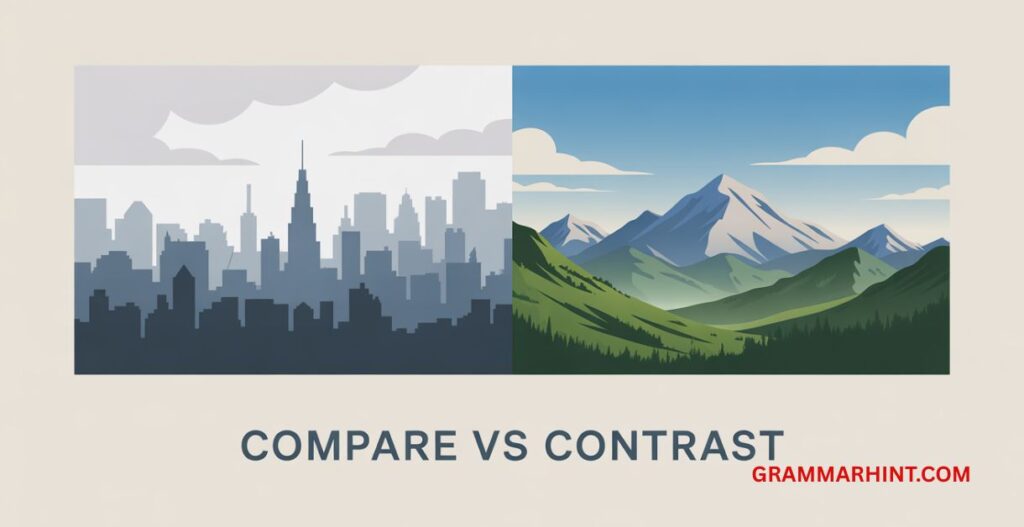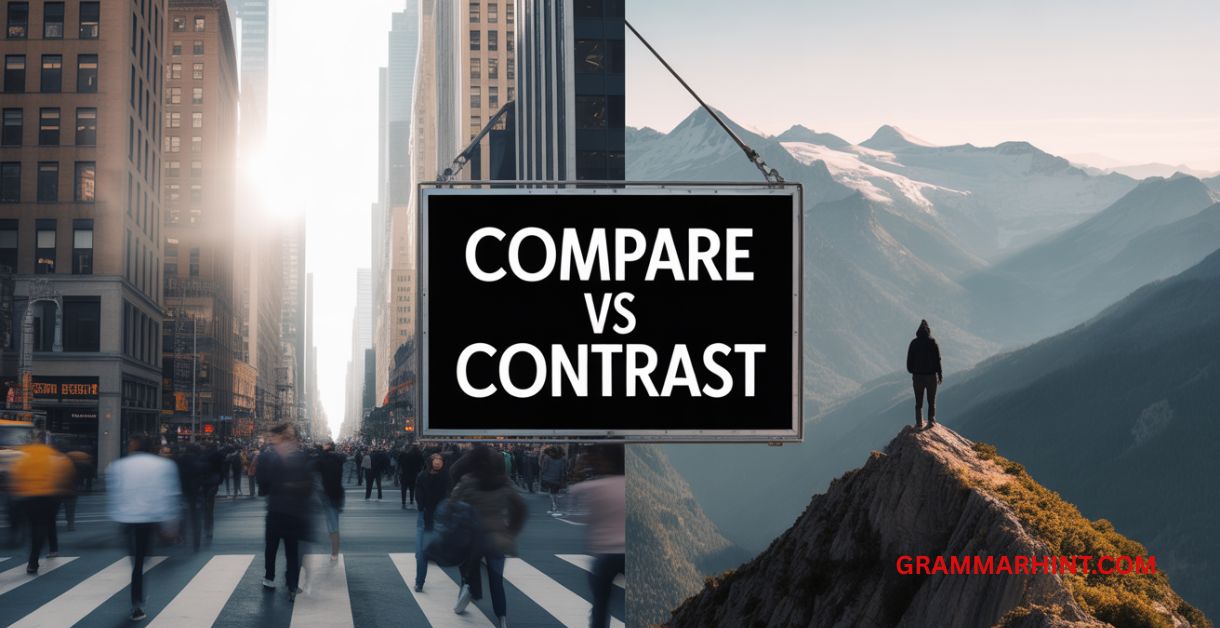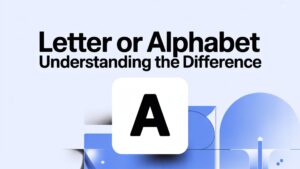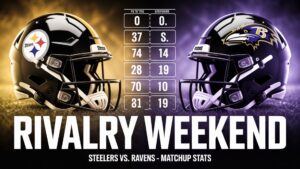Understanding the difference between compare and contrast is a fundamental skill in writing and analysis.
Whether you are crafting an academic essay, evaluating products, or just discussing ideas in everyday conversations, knowing what does compare and contrast mean and how to apply them effectively will improve your clarity and precision.
What Does Compare and Contrast Mean?
To begin, it’s essential to understand compare and contrast meaning at its core.
Compare means to examine two or more items, ideas, or subjects to identify their similarities that is, what they have in common. Conversely, contrast involves looking for differences what sets them apart. Together, compare and contrast allows us to see both the shared traits and unique aspects of things.
For example, when comparing two smartphones, you might note that both have high battery life and fast processing speed (similarities). When contrasting, you might highlight that one has a better camera quality, while the other offers a larger screen.
Why Are Compare and Contrast Important?
These skills help in critical evaluation, deepening understanding by identifying how things relate and differ. This dual approach is vital in academic settings (think academic comparison), product reviews, and even in creative endeavors like contrast in literature.
Compare vs Contrast: Definitions and Differences

Compare Definition
Compare is a verb used when we are conducting an evaluation to find common features. For instance, “Both online courses offer interactive quizzes and cover the same subject matter,” is a sentence that uses comparison phrases to draw out similarities.
Contrast Definition
Contrast, on the other hand, focuses on highlighting differences. A sentence such as, “Unlike the first course, the second relies heavily on lecture videos rather than live interaction,” uses contrast phrases like “unlike” to point out unique aspects.
Origins of Compare and Contrast
Understanding the origins of compare and contrast enriches our appreciation of their use.
- The word compare comes from the Latin comparare, meaning “to liken” or “to set side by side,” emphasizing linguistic comparison.
- Contrast entered English later, from the Italian contrastare, meaning “to stand against,” highlighting opposition and semantic difference.
How to Compare and Contrast: Grammar and Vocabulary Tips
Effective compare and contrast writing hinges on using the right vocabulary and grammar.
Comparative Adjectives and Phrases
Using comparative adjectives like “better,” “more efficient,” or “faster” helps to establish similarities or differences. For example:
- Comparison phrases: “Similarly,” “both,” “in the same way”
- Contrast phrases: “However,” “on the other hand,” “whereas,” “unlike”
Example:
- Compare: “Both laptops have long battery life and lightweight designs.”
- Contrast: “However, Laptop A has a more powerful processor, whereas Laptop B offers a higher-resolution screen.”
Display Contrast: Technical Example
In graphic design and device manufacturing, the term display contrast is crucial. It refers to the difference in luminance or color intensity between elements on screens and displays.
For example, a high display contrast makes text easily readable against backgrounds. This is particularly important in smartphones or monitors where clear visuals impact user experience. Designers must carefully balance contrast in display for aesthetics and accessibility.
Examples of Comparison and Contrast in Real Life
To make these concepts clearer, here are practical examples in different contexts.
Example 1: Email Comparing Two Online Courses
Subject: Feedback on Online Course Options
Hi Sarah,
After reviewing the two courses on digital marketing, I wanted to share my thoughts to help with your decision.
Both courses cover essential topics such as SEO and social media marketing, and they include interactive quizzes which I found quite engaging. However, Course A relies mostly on lecture videos, whereas Course B offers more live sessions, allowing for real-time questions.
Also, while Course A has a broader scope, Course B dives deeper into content strategy. I hope this helps you in your comparison.
Best,
James
Example 2: Contrast in a Product Review
Subject: Smartphone Comparison: Which One Should You Choose?
Hi Alex,
When choosing between the latest smartphones, it’s essential to compare and contrast their features carefully.
While both phones boast excellent battery life, the Camera quality on Phone X is superior, offering advanced night mode and zoom features. In contrast, Phone Y compensates with a longer processing speed and better integration with other devices.
So, if photography is your priority, Phone X might be the better choice. Otherwise, Phone Y is excellent for multitasking.
Cheers,
Maya
Academic Comparison: Writing Essays and Reports
In academia, compare and contrast writing is a common assignment. Understanding how to compare and how to contrast enables students to develop nuanced arguments.
Comparison Chart Example
| Aspect | Compare | Contrast |
|---|---|---|
| Purpose | Identify similarities | Identify differences |
| Focus | Common traits | Unique traits |
| Example Phrase | “Similarly,” “both,” “in the same way” | “Unlike,” “however,” “on the other hand” |
| Grammar Usage | Comparative adjectives (better, more) | Contrast phrases (whereas, unlike) |
| Application | Highlight connections between items | Emphasize distinct characteristics |
Synonyms of Compare and Contrast
Synonyms of Compare
- Evaluate
- Examine
- Assess
- Analyze
- Measure
- Appraise
These words focus on evaluation and drawing parallels in linguistic comparison.
Synonyms of Contrast
- Differentiate
- Distinguish
- Oppose
- Separate
- Juxtapose
- Discriminate
- Isolate
These emphasize pointing out differences or opposition, important in contrastive analysis.
Contrast in Literature and Writing
In literature, contrast is a powerful tool used to highlight conflicting themes, characters, or moods.
For example, an author might use contrast to show the difference between a protagonist’s optimism and an antagonist’s cynicism, deepening the story’s semantic difference and emotional impact.
How to Master Compare and Contrast in Writing
Step 1: Identify the Purpose
Decide if your focus is on evaluating similarities or identifying differences, or both.
Step 2: Use the Right Vocabulary
Incorporate comparative adjectives and comparison phrases when highlighting similarities, and contrast phrases when emphasizing differences.
Step 3: Organize Your Content
You can structure your writing in several ways:
- Point-by-point (alternating comparison and contrast of individual elements)
- Block method (discuss all comparisons first, then contrasts)
Step 4: Provide Clear Examples
Whether in emails, essays, or reports, use concrete examples for clarity.
Practical Scenario: Comparing Customer Service Emails
Email 1: Comparing Service Features
Hi Martin,
I wanted to highlight that both Company A and Company B offer 24/7 customer support and multilingual assistance. Both companies also provide online chat options for immediate help.
However, Company A has faster response times on average, which could be beneficial during peak hours.
Best regards,
Emma
Email 2: Contrasting Customer Service Approaches
Dear Lisa,
Unlike Company A, which provides phone support only during business hours, Company B offers round-the-clock live chat assistance. Additionally, Company A has a straightforward ticketing system, whereas Company B uses AI to prioritize urgent cases.
Hope this helps clarify the differences.
Cheers,
Tom
Vocabulary Tips for Compare and Contrast
- Use words like “similarly,” “likewise,” and “both” to indicate similarities.
- Use phrases like “in contrast,” “however,” “whereas,” and “unlike” to signal differences.
- Avoid mixing comparison and contrast phrases in the same sentence unless for a nuanced point.
Conclusion
Mastering compare and contrast techniques enhances your writing, whether for academic purposes, professional communication, or daily interactions. Understanding the compare vs contrast definition, their origins, and knowing how to apply comparative adjectives and phrases allows for more effective analysis.
From distinguishing features of smartphones and online courses to evaluating display contrast in screens and displays, the principles remain the same: identify similarities and differences clearly and logically.
By integrating these insights and practicing with real-world examples, you can confidently excel in compare and contrast writing, enriching your vocabulary and sharpening your grammar skills along the way.









